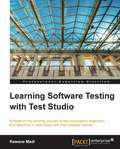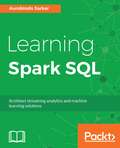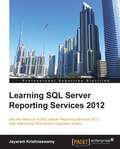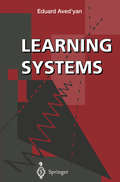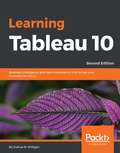- Table View
- List View
Learning ServiceNow: Administration and development on the Now platform, for powerful IT automation
by Tim WoodruffIT service management automation at your fingertipsAbout This BookLearn to leverage ServiceNow's capabilities for improved IT automation by following step-by-step, practical instructionsBuild core administration, development, and maintenance skills with IT service management in ServiceNowImprove your workflow efficiency by designing and creating responsive and automated workflows, business logic, and front-end automationWho This Book Is ForThis book is for IT professionals and administrators who are planning to or are already trying to implement ServiceNow in their organization for Enterprise IT service management tasks.Some familiarity with web technologies (JavaScript) would be helpful. Prior ServiceNow experience is not necessary.What You Will LearnRead and write clear, effective code for the ServiceNow platformIdentify and avoid common pitfalls and missteps that could seriously impact future progress and upgradeabilityUse debugging tools to troubleshoot when things go wrongDiscover tips and tricks from top ServiceNow developers, architects, and administrators. Find out what the pros wish they knew when they were starting outIn DetailThis book is an updated version of Learning ServiceNow, that will cover the new and updated features of the ServiceNow platform. It will show you how to put important ServiceNow features to work in the real world, while introducing key concepts via examples of managing and automating IT services. It'll help you build a solid foundation of knowledge, and will demonstrate how to effectively implement and configure modules within ServiceNow. We'll show you how to configure and administer your instance, and then move on to building strong user interfaces and creating powerful workflows.We also cover other key elements of ServiceNow, such as notifications, security, reporting, and custom development. You will learn how to improve and automate your business' workflow and processes. By the end of this book, you will be able to successfully configure and manage ServiceNow like a pro.Style and approachThis book is a step-by-step practical tutorial to help you quickly deploy and configure ServiceNow in your organization. It guides you through the process of building applications and understanding the underlying systems, to help you become a more effective ServiceNow/ITSM administrator and/or developer.
Learning ServiceNow: Administration and development on the Now platform, for powerful IT automation
by Tim WoodruffIT service management automation at your fingertipsAbout This BookLearn to leverage ServiceNow's capabilities for improved IT automation by following step-by-step, practical instructionsBuild core administration, development, and maintenance skills with IT service management in ServiceNowImprove your workflow efficiency by designing and creating responsive and automated workflows, business logic, and front-end automationWho This Book Is ForThis book is for IT professionals and administrators who are planning to or are already trying to implement ServiceNow in their organization for Enterprise IT service management tasks.Some familiarity with web technologies (JavaScript) would be helpful. Prior ServiceNow experience is not necessary.What You Will LearnRead and write clear, effective code for the ServiceNow platformIdentify and avoid common pitfalls and missteps that could seriously impact future progress and upgradeabilityUse debugging tools to troubleshoot when things go wrongDiscover tips and tricks from top ServiceNow developers, architects, and administrators. Find out what the pros wish they knew when they were starting outIn DetailThis book is an updated version of Learning ServiceNow, that will cover the new and updated features of the ServiceNow platform. It will show you how to put important ServiceNow features to work in the real world, while introducing key concepts via examples of managing and automating IT services. It'll help you build a solid foundation of knowledge, and will demonstrate how to effectively implement and configure modules within ServiceNow. We'll show you how to configure and administer your instance, and then move on to building strong user interfaces and creating powerful workflows.We also cover other key elements of ServiceNow, such as notifications, security, reporting, and custom development. You will learn how to improve and automate your business' workflow and processes. By the end of this book, you will be able to successfully configure and manage ServiceNow like a pro.Style and approachThis book is a step-by-step practical tutorial to help you quickly deploy and configure ServiceNow in your organization. It guides you through the process of building applications and understanding the underlying systems, to help you become a more effective ServiceNow/ITSM administrator and/or developer.
Learning Shell Scripting with Zsh
by Gaston FestariA step-by-step tutorial that will teach you, through real-world examples, how to configure and use zsh and its various features. If you are a system administrator, developer, or computer professional involved with UNIX who are looking to improve on their daily tasks involving the UNIX shell, "Learning Shell Scripting with zsh" will be great for you. It's assumed that you have some familiarity with an UNIX command-line interface and feel comfortable with editors such as Emacs or vi.
Learning Shiny
by Hernan G. ResnizkyMake the most of R's dynamic capabilities and implement web applications with Shiny About This Book • Present interactive data visualizations in R within the Shiny framework • Construct web dashboards in a simple, intuitive, but fully flexible environment • Apply your skills to create a real-world web application with this step-by-step guide Who This Book Is For If you are a data scientist who needs a platform to show your results to a broader audience in an attractive and visual way, or a web developer with no prior experience in R or Shiny, this is the book for you. What You Will Learn • Comprehend many useful functions, such as lapply and apply, to process data in R • Write and structure different files to create a basic dashboard • Develop graphics in R using popular graphical libraries such as ggplot2 and GoogleVis • Mount a dashboard on a Linux Server • Integrate Shiny with non-R-native visualization, such as D3.js • Design and build a web application In Detail R is nowadays one of the most used tools in data science. However, along with Shiny, it is also gaining territory in the web application world, due to its simplicity and flexibility. Shiny is a framework that enables the creation of interactive visualizations written entirely in R and can be displayed in almost any ordinary web browser. It is a package from RStudio, which is an IDE for R. From the fundamentals of R to the administration of multi-concurrent, fully customized web applications, this book explains how to achieve your desired web application in an easy and gradual way. You will start by learning about the fundamentals of R, and will move on to looking at simple and practical examples. These examples will enable you to grasp many useful tools that will assist you in solving the usual problems that can be faced when developing data visualizations. You will then walk through the integration of Shiny with R in general and view the different visualization possibilities out there. Finally, you will put your skills to the test and create your first web application! Style and approach This is a comprehensive, step-by-step guide that will allow you to learn and make full use of R and Shiny's capabilities in a gradual way, together with clear, applied examples.
Learning ShiVa3D Game Development
by Wade TracyThis book is a step-by-step, hands-on introduction to the basics of mobile game development with the ShiVa3D game engine. This book assumes no prior mobile game development or ShiVa3D experience, and is therefore suited to the absolute beginner looking to learn about both. Although previous programming experience will be beneficial, it is not necessary. Because game development platforms are so diverse, this book will also serve as a quick introduction for seasoned game developers that are looking to take advantage of the power of ShiVa3D. In either case the book also introduces the reader to resources for further learning.
Learning Single-page Web Application Development
by Fernando MonteiroThis book is aimed at web developers who are familiar with frontend technologies like JavaScript, HTML, and CSS, and modern tools like Bower, Yeoman, and Grunt.
Learning Social Media Analytics with R
by Raghav Bali Dipanjan Sarkar Tushar SharmaTap into the realm of social media and unleash the power of analytics for data-driven insights using R About This Book • A practical guide written to help leverage the power of the R eco-system to extract, process, analyze, visualize and model social media data • Learn about data access, retrieval, cleaning, and curation methods for data originating from various social media platforms. • Visualize and analyze data from social media platforms to understand and model complex relationships using various concepts and techniques such as Sentiment Analysis, Topic Modeling, Text Summarization, Recommendation Systems, Social Network Analysis, Classification, and Clustering. Who This Book Is For It is targeted at IT professionals, Data Scientists, Analysts, Developers, Machine Learning Enthusiasts, social media marketers and anyone with a keen interest in data, analytics, and generating insights from social data. Some background experience in R would be helpful, but not necessary, since this book is written keeping in mind, that readers can have varying levels of expertise. What You Will Learn • Learn how to tap into data from diverse social media platforms using the R ecosystem • Use social media data to formulate and solve real-world problems • Analyze user social networks and communities using concepts from graph theory and network analysis • Learn to detect opinion and sentiment, extract themes, topics, and trends from unstructured noisy text data from diverse social media channels • Understand the art of representing actionable insights with effective visualizations • Analyze data from major social media channels such as Twitter, Facebook, Flickr, Foursquare, Github, StackExchange, and so on • Learn to leverage popular R packages such as ggplot2, topicmodels, caret, e1071, tm, wordcloud, twittR, Rfacebook, dplyr, reshape2, and many more In Detail The Internet has truly become humongous, especially with the rise of various forms of social media in the last decade, which give users a platform to express themselves and also communicate and collaborate with each other. This book will help the reader to understand the current social media landscape and to learn how analytics can be leveraged to derive insights from it. This data can be analyzed to gain valuable insights into the behavior and engagement of users, organizations, businesses, and brands. It will help readers frame business problems and solve them using social data. The book will also cover several practical real-world use cases on social media using R and its advanced packages to utilize data science methodologies such as sentiment analysis, topic modeling, text summarization, recommendation systems, social network analysis, classification, and clustering. This will enable readers to learn different hands-on approaches to obtain data from diverse social media sources such as Twitter and Facebook. It will also show readers how to establish detailed workflows to process, visualize, and analyze data to transform social data into actionable insights. Style and approach This book follows a step-by-step approach with detailed strategies for understanding, extracting, analyzing, visualizing, and modeling data from several major social network platforms such as Facebook, Twitter, Foursquare, Flickr, Github, and StackExchange. The chapters cover several real-world use cases and leverage data science, machine learning, network analysis, and graph theory concepts along with the R ecosystem, including popular packages such as ggplot2, caret,dplyr, topicmodels, tm, and so on.
Learning Software Testing with Test Studio
by Rawane MadiLearning Software Testing with Test Studio is a practical, hands-on guide that will help you get started with Test Studio to design your automated solution and tests. All through the book, there are best practices and tips and tricks inside Test Studio which can be employed to improve your solution just like an experienced QA.If you are a beginner or a professional QA who is seeking a fast, clear, and direct to the point start in automated software testing inside Test Studio, this book is for you. You should be familiar with the .NET framework, mainly Visual Studio, C#, and SQL, as the book's examples rely on them. Prior testing knowledge will also be helpful.
Learning Spaces: Interdisciplinary Applied Mathematics
by Jean-Claude Falmagne Jean-Paul DoignonLearning spaces offer a rigorous mathematical foundation for practical systems of educational technology. Learning spaces generalize partially ordered sets and are special cases of knowledge spaces. The various structures are investigated from the standpoints of combinatorial properties and stochastic processes. Leaning spaces have become the essential structures to be used in assessing students' competence of various topics. A practical example is offered by ALEKS, a Web-based, artificially intelligent assessment and learning system in mathematics and other scholarly fields. At the heart of ALEKS is an artificial intelligence engine that assesses each student individually and continously. The book is of interest to mathematically oriented readers in education, computer science, engineering, and combinatorics at research and graduate levels. Numerous examples and exercises are included, together with an extensive bibliography.
Learning Spark SQL
by Aurobindo SarkarDesign, implement, and deliver successful streaming applications, machine learning pipelines and graph applications using Spark SQL API About This Book • Learn about the design and implementation of streaming applications, machine learning pipelines, deep learning, and large-scale graph processing applications using Spark SQL APIs and Scala. • Learn data exploration, data munging, and how to process structured and semi-structured data using real-world datasets and gain hands-on exposure to the issues and challenges of working with noisy and "dirty" real-world data. • Understand design considerations for scalability and performance in web-scale Spark application architectures. Who This Book Is For If you are a developer, engineer, or an architect and want to learn how to use Apache Spark in a web-scale project, then this is the book for you. It is assumed that you have prior knowledge of SQL querying. A basic programming knowledge with Scala, Java, R, or Python is all you need to get started with this book. What You Will Learn • Familiarize yourself with Spark SQL programming, including working with DataFrame/Dataset API and SQL • Perform a series of hands-on exercises with different types of data sources, including CSV, JSON, Avro, MySQL, and MongoDB • Perform data quality checks, data visualization, and basic statistical analysis tasks • Perform data munging tasks on publically available datasets • Learn how to use Spark SQL and Apache Kafka to build streaming applications • Learn key performance-tuning tips and tricks in Spark SQL applications • Learn key architectural components and patterns in large-scale Spark SQL applications In Detail In the past year, Apache Spark has been increasingly adopted for the development of distributed applications. Spark SQL APIs provide an optimized interface that helps developers build such applications quickly and easily. However, designing web-scale production applications using Spark SQL APIs can be a complex task. Hence, understanding the design and implementation best practices before you start your project will help you avoid these problems. This book gives an insight into the engineering practices used to design and build real-world, Spark-based applications. The book's hands-on examples will give you the required confidence to work on any future projects you encounter in Spark SQL. It starts by familiarizing you with data exploration and data munging tasks using Spark SQL and Scala. Extensive code examples will help you understand the methods used to implement typical use-cases for various types of applications. You will get a walkthrough of the key concepts and terms that are common to streaming, machine learning, and graph applications. You will also learn key performance-tuning details including Cost Based Optimization (Spark 2.2) in Spark SQL applications. Finally, you will move on to learning how such systems are architected and deployed for a successful delivery of your project. Style and approach This book is a hands-on guide to designing, building, and deploying Spark SQL-centric production applications at scale.
Learning Spring 5.0
by Tejaswini Mandar JogBuild, test, and secure robust enterprise-grade applications using the Spring Framework About This Book • Build an enterprise application throughout the book that communicates with a microservice • Define and inject dependencies into your objects using the IoC container • Make use of Spring's reactive features including tools and implement a reactive Spring MVC application Who This Book Is For This book is for Java developers who want to make use of the Spring framework to simplify their programming needs. What You Will Learn • Get to know the basics of Spring development and gain fundamental knowledge about why and where to use Spring Framework • Explore the power of Beans using Dependency Injection, wiring, and Spring Expression Language • Implement and integrate a persistent layer in your application and also integrate an ORM such as Hibernate • Understand how to manage cross-cutting with logging mechanism, transaction management, and more using Aspect-oriented programming • Explore Spring MVC and know how to handle requesting data and presenting the response back to the user • Get to grips with the integration of RESTful APIs and Messaging with WebSocket and STOMP • Master Reactive Programming using Spring MVC to handle non-blocking streams In Detail Spring is the most widely used framework for Java programming and with its latest update to 5.0, the framework is undergoing massive changes. Built to work with both Java 8 and Java 9, Spring 5.0 promises to simplify the way developers write code, while still being able to create robust, enterprise applications. If you want to learn how to get around the Spring framework and use it to build your own amazing applications, then this book is for you. Beginning with an introduction to Spring and setting up the environment, the book will teach you in detail about the Bean life cycle and help you discover the power of wiring for dependency injection. Gradually, you will learn the core elements of Aspect-Oriented Programming and how to work with Spring MVC and then understand how to link to the database and persist data configuring ORM, using Hibernate. You will then learn how to secure and test your applications using the Spring-test and Spring-Security modules. At the end, you will enhance your development skills by getting to grips with the integration of RESTful APIs, building microservices, and doing reactive programming using Spring, as well as messaging with WebSocket and STOMP. Style and approach Filled with examples, this tutorial-based book will help you gain all the knowledge you need to start producing enterprise-grade applications with Spring.
Learning Spring Application Development
by Ravi Kant SoniThis book is intended for those who are interested in learning the core features of the Spring Framework. Prior knowledge of Java programming and web development concepts with basic XML knowledge is expected.
Learning Spring Boot
by Greg L. TurnquistThis book is for both novice developers in general and experienced Spring developers. It will teach you how to override Spring Boot's opinions and frees you from the need to define complicated configurations.
Learning SQL Server 2008 Reporting Services
by Jayaram KrishnaswamyWith clear instructions and plenty of screenshots, this book provides all the support and guidance you will need as you begin to generate reports with SQL Server 2008 Reporting Services. This book is for anyone who is new to SQL Server 2008 Reporting Services and needs to create and deploy reports. The book is suitable for report developers, data analysts, and report server database administrators. You will need to know the basic concepts of SQL Server, but not necessarily be very familiar with SQL Server 2008.
Learning SQL Server Reporting Services 2012
by Jayaram KrishnaswamyThe book is packed with clear instructions and plenty of screenshots, providing all the support and guidance you will need as you begin to generate reports with SQL Server 2012 Reporting Services.This book is for those who are new to SQL Server Reporting Services 2012 and aspiring to create and deploy cutting edge reports. This book is for report developers, report authors, ad-hoc report authors and model developers, and Report Server and SharePoint Server Integrated Report Server administrators. Minimal knowledge of SQL Server is assumed and SharePoint experience would be helpful.
Learning Stencyl 3.x Game Development: Beginner's Guide
by Innes BorkwoodA step-by-step, practical tutorial with a no-nonsense approach. The book starts by showing readers how to create a playable game that is fully-functioning, then moves on to demonstrate how to fine-tune the game with eye-catching graphics techniques, audio-effects and more.This book is for indie and existing game developers and those who want to get started with game development using Stencyl. Some understanding of Objective-C, C++, and game development basics is recommended. People with some programming experience may also find this book useful.
Learning Storm
by Ankit Jain Anand NalyaIf you are a Java developer who wants to enter into the world of real-time stream processing applications using Apache Storm, then this book is for you. No previous experience in Storm is required as this book starts from the basics. After finishing this book, you will be able to develop not-so-complex Storm applications.
Learning Structure and Schemas from Documents (Studies in Computational Intelligence #375)
by Marenglen Biba Fatos XhafaThe rapidly growing volume of available digital documents of various formats and the possibility to access these through Internet-based technologies, have led to the necessity to develop solid methods to properly organize and structure documents in large digital libraries and repositories. Due to the extremely large volumes of documents and to their unstructured form, most of the research efforts in this direction are dedicated to automatically infer structure and schemas that can help to better organize huge collections of documents and data. This book covers the latest advances in structure inference in heterogeneous collections of documents and data. The book brings a comprehensive view of the state-of-the-art in the area, presents some lessons learned and identifies new research issues, challenges and opportunities for further research agenda and developments. The selected chapters cover a broad range of research issues, from theoretical approaches to case studies and best practices in the field. Researcher, software developers, practitioners and students interested in the field of learning structure and schemas from documents will find the comprehensive coverage of this book useful for their research, academic, development and practice activity.
Learning Swift
by Andrew J WagnerIf you are looking to build iOS or OS X apps using the most modern technology, this book is ideal for you. You will find this book especially useful if you are new to programming or if you have yet to develop for iOS or OS X.
Learning Swift - Second Edition
by Andrew J WagnerDevelop the skills required to create compelling, maintainable, and robust iOS and OS X apps with SwiftAbout This BookWrite expressive, understandable, and maintainable Swift 2 code with this hands-on tutorialUnveil the complex underpinnings of Swift to turn your app ideas into realityThis book is packed with real-life examples to help you implement concepts as you learnWho This Book Is ForIf you are looking to build iOS or OS X apps using the most modern technology, this book is ideal for you. You will find this book especially useful if you are new to programming or if you are yet to develop for iOS or OS X. No prior programming exposure is required.What You Will LearnForm a solid understanding of the Swift 2 languageGet to know the practical aspects of how a computer program actually worksUnderstand the paradigms used by Apple's frameworks so you are not intimidated by themUtilize the vast resources written in Objective-C to better inform your Swift programmingDevelop a basic portfolio of Swift code by learning the critical conceptsExperience both object-oriented and functional programmingGet to know the new coding techniques made available by Swift 2Discover resources to ensure you never stop becoming a better developerIn DetailSwift is Apple's new programming language and the future of iOS and OS X app development. It is a high-performance language that feels like a modern scripting language. On the surface, Swift is easy to jump into, but it has complex underpinnings that are critical to becoming proficient at turning an idea into reality.This book is an approachable, step-by-step introduction into programming with Swift for everyone. It begins by giving you an overview of the key features through practical examples and progresses to more advanced topics that help differentiate the proficient developers from the mediocre ones. It covers important concepts such as Variables, Optionals, Closures, Generics, and Memory Management. Mixed in with those concepts, it also helps you learn the art of programming such as maintainability, useful design patterns, and resources to further your knowledge. This all culminates in writing a basic iOS app that will get you well on your way to turning your own app ideas into reality.Style and approachThis is an approachable, step-by-step guide to programming in Swift 2. Each topic is separated into compressible sections that are full of practical examples and easy-to-understand explanations. Each section builds on the previous topics so you can develop a proficient and comprehensive understanding of app development in Swift 2.
Learning System Center App Controller
by Nasir NaeemThis book is intended for IT professionals working with Hyper-V, Azure cloud, VMM, and private cloud technologies who are looking for a quick way to get up and running with System Center 2012 R2 App Controller. To get the most out of this book, you should be familiar with Microsoft Hyper-V technology. Knowledge of Virtual Machine Manager is helpful but not mandatory.
Learning Systems
by Eduard Aved'yanA learning system can be defined as a system which can adapt its behaviour to become more effective at a particular task or set of tasks. It consists of an architecture with a set of variable parameters and an algorithm. Learning systems are useful in many fields, one of the major areas being in control and system identification. This work covers major aspects of learning systems: system architecture, choice of performance index and methods measuring error. Major learning algorithms are explained, including proofs of convergence. Artificial neural networks, which are an important class of learning systems and have been subject to rapidly increasing popularity, are discussed. Where appropriate, examples have been given to demonstrate the practical use of techniques developed in the text. System identification and control using multi-layer networks and CMAC (Cerebellar Model Articulation Controller) are also presented.
Learning Systems: From Theory to Practice (Studies in Computational Intelligence #756)
by Vassil Sgurev Vincenzo Piuri Vladimir JotsovBy presenting the latest advances in fuzzy sets and computing with words from around the globe, this book disseminates recent innovations in advanced intelligent technologies and systems. From intelligent control and intuitionistic fuzzy quantifiers to various data science and industrial applications, it includes a wide range of valuable lessons learned and ideas for future intelligent products and systems.
Learning Tableau
by Joshua N. MilliganIf you want to understand your data using data visualization and don't know where to start, then this is the book for you. Whether you are a beginner or have years of experience, this book will help you to quickly acquire the skills and techniques used to discover, analyze, and communicate data visually. Some familiarity with databases and data structures is helpful, but not required.
Learning Tableau 10 - Second Edition
by Joshua N. MilliganLearn how to create effective data visualizations with Tableau and unlock a smarter approach to business analytics. It might just transform your organizationAbout This BookCreate stylish visualizations and dashboards that explain complexity with clarityLearn effective data storytelling to transform how your business uses ideas and makes decisionsExplore all the new features in Tableau 10 and start to redefine what business analytics means to your organizationWho This Book Is ForGot data? Not sure what to make of it? This is the guide for you – whether you've been working with Tableau for years or are just beginning your adventure into business analytics.What You Will LearnFind out how to build effective visualizations and dashboardsPrepare and clean your data so you can be sure Tableau is finding answers to your questions – not raising more problemsDiscover how to create advanced visualizations that explain complexity with clarity and styleDig deeper into your data with clustering and distribution models that allow you to analyze trends and make forecastsLearn how to use data storytelling to aid decision-making and strategyShare dashboards and visualizations to cultivate a culture where data is available and valuedIn DetailTableau has for some time been one of the most popular Business Intelligence and data visualization tools available. Why? Because, quite simply, it's a tool that's responsive to the needs of modern businesses. But it's most effective when you know how to get what you want from it – it might make your business intelligent, but it isn't going to make you intelligent...We'll make sure you're well prepared to take full advantage of Tableau 10's new features. Whether you're an experienced data analyst that wants to explore 2016's new Tableau, or you're a beginner that wants to expand their skillset and bring a more professional and sharper approach to their organization, we've got you covered. Beginning with the fundamentals, such as data preparation, you'll soon learn how to build and customize your own data visualizations and dashboards, essential for high-level visibility and effective data storytelling. You'll also find out how to so trend analysis and forecasting using clustering and distribution models to inform your analytics.But it's not just about you – when it comes to data it's all about availability and access. That's why we'll show you how to share your Tableau visualizations. It's only once insights are shared and communicated that you – and your organization – will start making smarter and informed decisions. And really, that's exactly what this guide is for.Style and approachPractical yet comprehensive, this Tableau guide takes you from the fundamentals of the tool before diving deeper into creating advanced visualizations. Covering the latest features found in Tableau 10, this might be the guide that transforms your organization.






